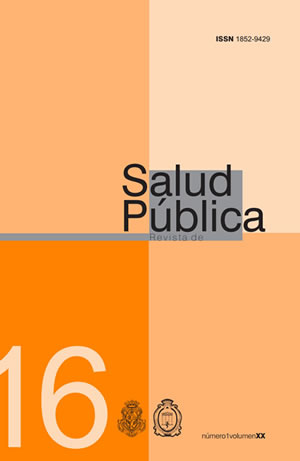OCULAR PATHOLOGIES IN CHILDREN: VAL-IDATION STUDY OF A SCREENING METHOD DURING SCHOOL YEARS. MARCH - DECEM-BER 2010, MONTEVIDEO, URUGUAY.
DOI:
https://doi.org/10.31052/1853.1180.v20.n1.12741Keywords:
screening, visual acuity, strabismus, studentsAbstract
The objective of the «National Program of Ocular Health» is to tackle the avoidable and treatable causes of blindness. Within this framework, the Department of Community and Family Medicine has developed activities related to Health Promotion and Prevention of ocular illnesses and problems in childhood. This activity was planned and took place in an interdisciplinary way, with the participation of medical degree students, students of opthalmology, and ophthalmologists and with the participation of different sectors suc has Hospital de Ojos, Ministry of Social Development and the Chamber of Opticians. This work includes the assessment of competences acquired by the students when screening visual alterations (inter-observer agreement degree). The objective was to evaluate the validity and safety of medical students applying a screening method of ocular pathology in kindergarten and school students at three institutions of Zonal 12 in Montevideo (March-December 2010). Method: Medical students were trai ned with a blended-learning approach (attending classes and on line classes) and offi ce practices. Screening days were double blind and kids were evaluated by a student and an ophthalmologist. Visual acuity with Snellen Chart and ocular alignment using the Hirsch berg test were systematically explored. Results: One hundred ninety-six children between 5 and 8 years old were studied; 13.7 % required referral due to defi cit in visual acuity and 2.5% because of strabism us. The agreement between students and technicians regarding referral due to visual acuity defi cit was 94% and strabismus 96%. Kappa value for visual acuity was 0.77 and for strabismus 0.53. Students ́sensitivity for visual acuity was 88 .9% and 100% for strabismus. Specifi city was 94.7% for visual acuity and 95.8% for strabismu s. Positive predictive value was 72.7% for visual acuity and 38.4% for strabismus and the negative predictive value was 98.1% for visual acuity and 100% for strabismus. conclusions: The percentage of derivatives is similar to that of previous works. From the results of the study, it would be appropriate to include the screening of visual alterations by trained medical students at educational institutions, since it optimizes interventions at primary health care.Downloads
References
Organización Mundial de la Salud. Programa 2020. www.v2020.org, consultada en julio 2015.
Ministerio de Salud Pública. Programa Nacional de salud Ocular. Uruguay 2006.
Landis J, Koch G: The measurement of observeragreement for categorical data. Biometrics 1977; 33:159-74.
Barría von B, Fernando. Programa de salud ocular en Chile. Solución Integral a la atención oftalmológica propuesta por la Sociedad Chilena de Oftalmología en el año 2003. Arch. Chil. Oftalmol. 2005;62(1-2):15-20
Gasparetto Merf, Temporini ER, Monteiro de Carvalho KM, Kara-José N, Dificuldade visual em escolares: conhecimentos e acoes de professores do ensino fundamental que atuan con alunos que apresentam visaô subnormal. Arq Bras Oftalmol. 2004.
Pareja Ríos A., Martínez Piñero A., Abreu Reyes JA., Serrano García M. Estudio de la Agudeza Visual y Ambliopía en los niños de 3 a 5 años de El Hierro. Archivos de la Sociedad Española de Oftalmología, Número 6, Volumen 75. Junio, 2000.
Larrosa I, Pizzichillo A, Freccero V. Integración de la Licenciatura en oftalmología al Instituto de APS de la Facultad de Medicina. Uruguay, 2007.
Cerda, J.L.1, Luis Villarroel del P. Evaluación de la concordancia inter-observador en investigación pediátrica: Coeficiente de Kappa Rev Chil Ped. 2008; 79 (1): 54-58
Barría von B, F., Guzmán M.P, Villaseca I. y Von Bischhoffhausen, C. Programa nacional de JUNAEB Salud Escolar Oftalmológica. Análisis de resultados. Arch. Chil. Oftalmol. 62(1/2): 117-123, 2005. tab. graf. .
Schonhaut L, Rodríguez L, Pizarro T, Kohn J, Meri-no D, López A, et al: Concordancia en el diagnósticonutricional según coeficiente de masa corporal, entre el equipo de salud y las escuelas de la comuna de coli-na. Rev Chil Pediatr 2004; 75: 32-5.
Urzúa S, Duffau G, Zepeda G, Sagredo S: Estudio deconcordancia clínica en educandos de pre y postítuloen pediatría: puntaje de tal. Rev Chil Pediatr 2002;73: 471-7.
Pinheiro A, Urteaga C, Canete G, Atalah E: Evalua-ción del estado nutricional en niños con síndrome deDown según diferentes referencias antropométricas.Rev Chil Pediatr 2003; 74: 585-9.
Barría von B, Fernando. Programa de salud ocular en Chile. Solución Integral a la atención oftalmológica propuesta por la Sociedad Chilena de Oftalmología en el año 2003. Arch. Chil. Oftalmol. 2005;62(1-2):15-20
Administración Nacional de Educación Pública. Tercer Censo Nacional de talla en niños de 1er grado escolar. Montevideo, 2003. ISBN: 978-9974-644-33-5
Downloads
Published
How to Cite
Issue
Section
License
Copyright (c) 2016 Escuela de Salud Pública y Ambiente. Facultad de Ciencias Médicas. Universidad Nacional de Córdoba

This work is licensed under a Creative Commons Attribution-NonCommercial 4.0 International License.
Authors who publish with this journal agree to the following terms:
- Authors retain copyright and grant the journal right of first publication with the work simultaneously licensed under a Creative Commons Attribution License which allows the work to be copied, distributed, exhibited and interpreted as long as it is not done for commercial purposes.
- Authors are able to enter into separate, additional contractual arrangements for the non-exclusive distribution of the journal's published version of the work (e.g., post it to an institutional repository or publish it in a book), with an acknowledgement of its initial publication in this journal.
- Authors are permitted and encouraged to post their work online (e.g., in institutional repositories or on their website) after the publication process. (See The Effect of Open Access). (See The Effect of Open Access).



